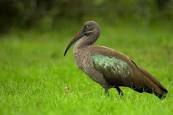Egyptian Goose


Hadeda Ibis


Probably one of the most well known of the ibises. These noisy birds were found mainly in the Lowveld, but with their habitat being destroyed and the rate of breeding, they have spread into the Highveld and drier areas.
Their main predator here is the Crowned Eagle. They eat mainly insects, crustaceans, spiders, snails, small reptiles and earthworms.
Wooly Necked Stork
These lovely birds were once a rarity down here in Leisure Bay. They have become more common in recent years since moving further south. They will take up residence on properties if the home-owner or resident leaves food out for them. They normally eat large insects, molluscs, crabs, fish, frogs, lizards and sometimes oil palm fibres. They also seem to enjoy stale bread, mielie pap and braai leftovers. They very rarely make any sound. If you hear loud bill-clattering in your garden, look up into the trees.... it is probably a wooly-neck.
Reed Cormorant
 This bird occupies almost any freshwater habitat, excluding fas-moving water. However, it prefers bodies of water with gently sloping shores.
This bird occupies almost any freshwater habitat, excluding fas-moving water. However, it prefers bodies of water with gently sloping shores.
It is a small cormorant, about 55cm in length and a wingspan of about 85cm. It is mainly black with a greenish gloss. It has a yellow face patch and a yellow bill.
It dives mainly for slow swimming fish, frogs and birds. It can dive quite deeply but prefers shallow waters.
It lays two to four eggs in a tree or on the ground, hidden by long grass.
Blue Crane
 This bird is not supposed to be here, and yet several people have seen it near Clearwater Trails near Umtamvuna Nature Reserve. I saw one there and the people with me did not believe it. It appears that this National bird is in our area. It occurs in cultivated land and this one was in a macadamia plantation.
This bird is not supposed to be here, and yet several people have seen it near Clearwater Trails near Umtamvuna Nature Reserve. I saw one there and the people with me did not believe it. It appears that this National bird is in our area. It occurs in cultivated land and this one was in a macadamia plantation.
When breeding it is shy. Otherwise it is fairly tame and learns quickly how to open chalet doors. If you have a breakfast braai and one is nearby, watch your toast and sausages or they will be swiped from under your nose!
They are highly intelligent and quite funny. And they are quite elegant.
They eat frogs, reptiles, insects, fish, grain, green shoots and grass seeds.
Breeding October to February.
Goliath Heron
 The Goliath Heron is quite large, about 140cm in length. It has a yellow iris, The bill above is black and the bill below is horn coloured. It is a large bird, mainly slate and chestnut. The legs tend to hang below when in flight.
The Goliath Heron is quite large, about 140cm in length. It has a yellow iris, The bill above is black and the bill below is horn coloured. It is a large bird, mainly slate and chestnut. The legs tend to hang below when in flight.
It is a slow flier. Not that common here but it can be seen standing in water waiting for chow.
It's main meal is fish and frogs, small reptiles amd carrion, crustaceans and small mammals.
Burchelle's Coucal
 Also known as the whitebrowed coucal, this large bird reaches the size of 38-44cm. The iris is crimson and the bill, legs and feet are black or bluish grey.
Also known as the whitebrowed coucal, this large bird reaches the size of 38-44cm. The iris is crimson and the bill, legs and feet are black or bluish grey.
The bird has retained the name "Burchell's Coucal" because as most South African birds have white eyebrows, the name for this bird was retained as the Burchell's Coucal. Thank goodness, or we would have yet another bird to hunt for in the books!
It has a diet of insects, small frogs, reptiles, nestling birds and mammals, and can be seen, especially on cloudy, drizzly days, perched on low bushes.
The call (something like water being poured out of a bottle, hence the common name Bottlebird) is well known, but hopfully we'll have a birdcall section up soon.
| Back | Back to top |


